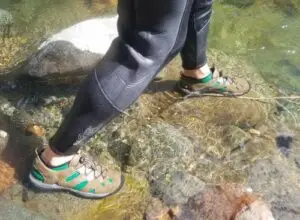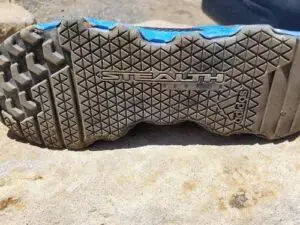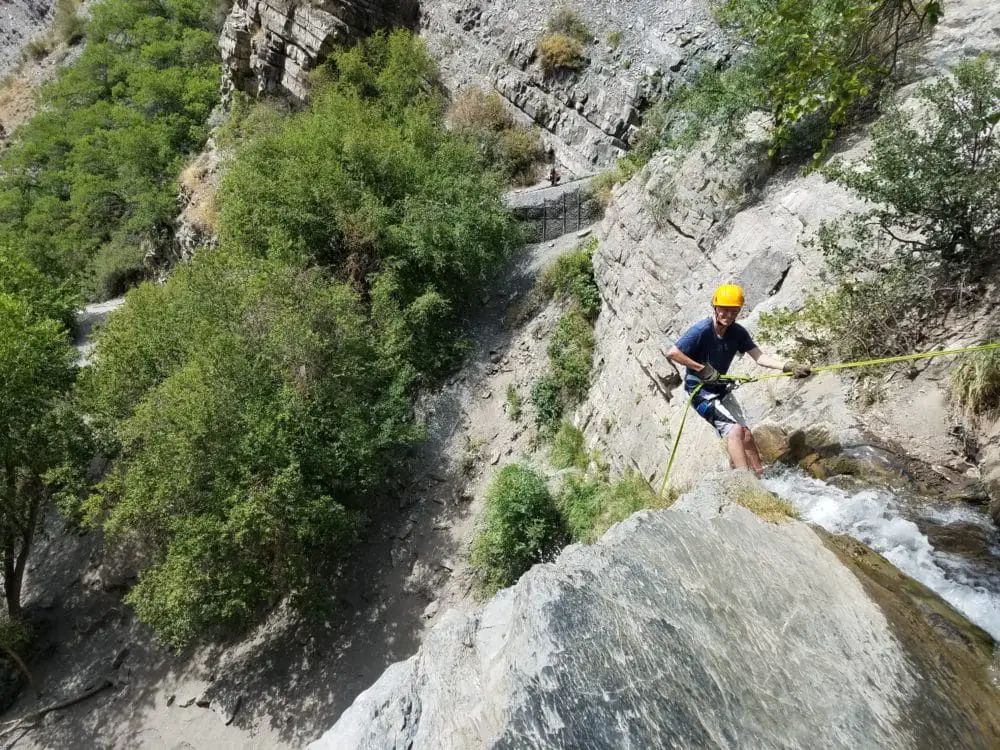Waterfall rappelling is exhilarating. My intro into canyoneering actually started with a waterfall rappel. There are a lot of vacation places where you can go waterfall rappelling, like Costa Rica, Belize, Maui Hawaii, or the Philippines. Whether you’re going on a self-guided waterfall rappel or a waterfall rappel tour on vacation, you need to wear the right clothing.
Wear a quick-drying shirt, quick-drying shorts that are at least mid-thigh length or long pants, and durable hiking sandals that cover your toes or old tennis shoes. Some tour companies provide special canyoning shoes. A helmet is a must for waterfall rappelling, but will be provided by any tour company. In certain seasons and locations, a wetsuit is recommended.
Rappelling off of a waterfall is a ton of fun, and is definitely bucket-list worthy. It is a very safe activity, especially when done through a reputable guide company.
Gear for Waterfall Rappelling
If you’ve never spent any time canyoneering (canyoning, barranquismo, canonismo, kloofing, gorge walking, river tracing ), then you may not have any idea what to wear for waterfall rappelling on a guided excursion or tour. It is important to keep in mind that you need to be covered up enough that the harness and rope don’t press into your skin, but also wear thin enough clothing that you will dry off quickly afterwards.
), then you may not have any idea what to wear for waterfall rappelling on a guided excursion or tour. It is important to keep in mind that you need to be covered up enough that the harness and rope don’t press into your skin, but also wear thin enough clothing that you will dry off quickly afterwards.
Waterfall Rappelling in Warm Locations: Most of the waterfall rappelling excursions around the world occur in warm locations and climates. In many places the water is even lukewarm! If this is the case, your best bet is to wear thin quick-drying shirts and shorts that cover at least the area a harness would rub on (mid-thigh to hips).
- For Men: I wear a quick-drying swimsuit that goes to my knees and a quick-drying t-shirt.
- For Women: Wear shorts that are at least mid-thigh length because the harness leg loops can be very uncomfortable up against your skin. A tank top or quick-drying t-shirt tucked underneath the harness will protect your upper body from abrasions. It’s probably easiest to wear a swimsuit underneath, as many guided tours include swimming at the base of the waterfall afterwards and the material dries quickly. Make sure to have hair ties so you can keep your hair out of the way of the rappel device.
If you haven’t rappelled before, or haven’t rappelled much, consider wearing long pants. You will probably scrape your knees against the cliff a time or two, and long pants will protect your skin.
Waterfall Rappelling in Cold Weather or Cold Water: Since you’ll likely rappel through the midst of a torrent of water crashing down on your head, there’s really no way to stay dry. If the air and water will be cold, or if the exposure will be long, you will need to wear a wetsuit.
If you are going on a commercially-guided waterfall rappel tour they will probably supply you with wetsuits, but it’s best to check with them beforehand. If you are looking to get your own wetsuit, check out our Recommended Gear Page (Wetsuits) .
.

Unless you are in a tropical location, I recommend getting a pair of neoprene socks to keep your feet warm. You’ll probably spend some time standing in cold water before going over the edge, and 3-5mm neoprene socks do a lot to warm up your toes! I wear the Ketos 3mm Neoprene socks for all cold water activities, and they’re a life-saver.
for all cold water activities, and they’re a life-saver.

Shoes for Waterfall Rappelling
The shoes you wear for waterfall rappelling are extremely important. Conditions will be very slippery with water and moss buildup, so you need to have really good traction. They also need to support your feet well enough that you don’t slide around and need to protect the toes and sides of your feet from rocks and other surfaces.
If you plan to do a waterfall rappel on vacation in a place like Costa Rica, Maui, or the Philippines, make sure your shoes will either dry quickly or can be worn wet. You can’t just leave them out on your porch to dry for a week if you are travelling.
The best shoes to wear for waterfall rappelling are hiking sandals like Tevas or Keens. They offer good traction, good protection, and great drainage. They are comfortable enough to hike in, and durable enough for most water activities. Make sure your hiking sandals cover your toes, since a lot of waterfall rappel hikes involve treading through streams and rivers where you will likely kick hidden rocks and sticks.

Another option for waterfall rappelling that is a little bit more versatile is approach shoes . These are a hybrid between hiking boots and running shoes- basically modern hiking boots. I love the Adidas Terrex family of shoes and wear the Terrex Aqua Pro (view on Amazon)
. These are a hybrid between hiking boots and running shoes- basically modern hiking boots. I love the Adidas Terrex family of shoes and wear the Terrex Aqua Pro (view on Amazon) as my waterfall rappelling and wet canyoneering shoe. Really just anything with Terrex “Stealth Rubber” will get the job done.
as my waterfall rappelling and wet canyoneering shoe. Really just anything with Terrex “Stealth Rubber” will get the job done.

Hiking Boots can provide great traction, though not always when wet. They do provide excellent foot protection but will take forever to dry. They can also become very heavy when water-logged, and don’t drain water at all. It can be hazardous to swim with them on and tiring to hike out with wet boots.
If you’re going waterfall rappelling one time on vacation, and don’t plan on doing similar activities, you can definitely make do with tennis shoes. You won’t have the best traction as you rappel, but they will protect your feet and dry out relatively quickly afterwards. Make sure you have a backup pair of shoes or sandals to use for other activities during your trip.
DON’T wear flip flops or other flimsy sandals that don’t cover your toes. Your feet will slide around and you could get injured.
Some guiding companies provide specialized footwear for you to use like the Adidas Terrex Hydrolace (view on Amazon) , so check in with them before you go.
, so check in with them before you go.
For more information on the best footwear for waterfall rappelling and canyoneering, check out our article What are the Best Shoes for Canyoneering?

Helmet for Waterfall Rappelling
Helmets should always be worn when rappelling, due to the risk of knocking rocks down or accidental falls. There are often loose rocks near the edge of rappels, or flakes of rocks than can break off. Other rappellers may also drop equipment. A head injury in the backcountry is a very dangerous possibility.
With waterfall rappelling, the risk is slightly exacerbated. The flowing river or stream can carry rocks of many different sizes in it. Very fast flowing water can even carry larger rocks and logs in it.
In a commercially guided trip they usually clear the edge of the falls of rocks and other falling hazards, and don’t rappel down falls that flow enough to send big rocks over the edge.
A helmet will protect your head from smaller rocks that slow-moving water carries, but also helps keep the water out of your eyes and face because it rolls off of the edges of the helmet instead of down your face.
All reputable guide services will require that users wear helmets, and they will most likely provide them. For more information on the helmets we use and recommend, see our Recommended Gear Page-Helmets.
Popular places to go Waterfall Rappelling Commercially
The most popular place to go waterfall rappelling is Costa Rica. They’ve developed a really strong reputation for adventure sports in recent years, and many adventurers visit the country. The website Vacationscostarica.com provides some information on tours like the famous Arenal that are available. Belize is another Central America option for waterfall rappelling.
provides some information on tours like the famous Arenal that are available. Belize is another Central America option for waterfall rappelling.
Hawaii also includes several locations for waterfall rappelling, though none on Oahu. AdventureMaui highlights the options in Maui, and AdventureinHawaii.com
highlights the options in Maui, and AdventureinHawaii.com offers options on Kauai and on the Big Island.
offers options on Kauai and on the Big Island.
The Philippines has a lot of canyoning and waterfall rappelling, including the world-famous Kawasan Falls with its bright blue water.
I haven’t been to these places or used these companies (yet), but I’ve done a lot of waterfall rappelling around Utah and Arizona in Class C canyoneering.
Related Questions
Is Waterfall Rappelling Safe? When done properly, waterfall rappelling is not dangerous. Ropes and other safety equipment are more than adequate to provide protection, and any tour will provide additional safety measures like lifejackets and belayers.
More Information: Is Canyoning Dangerous? Canyoneering Safety Tips
Is Waterfall Rappelling Scary? Stepping backwards over the edge of a cliff with flowing water around your ankles is very intense. Guides do a good job helping you feel safe and comfortable, but the ever-present fear of heights doesn’t go away until the excitement and adrenaline take over.
More Information: How to Rappel
Is Waterfall Rappelling the same as Canyoneering? Waterfall Rappelling usually refers to a guided tour of a canyoneering-like adventure. Canyoneering tours and waterfall rappelling tours are the same, but canyoneering often includes longer hikes and other obstacles.
More Information: What is Canyoneering?

